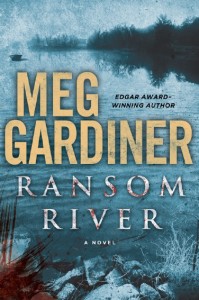by Meg Gardiner
The Kill Zone is delighted to welcome Edgar Award-winning author Meg Gardiner. The Boston Globe says of her latest thriller: “RANSOM RIVER is everything you want in a blockbuster thriller: multiple plot twists, thoroughly creepy psychotic villains, danger at every turn.” In other words: “It’s awesome!” Meg’s latest is a departure from her popular series, and today she discusses a critical question for every thriller author.
Thrillers toss characters into danger. They force cops to chase maniacs through dark woods. They make covert agents disarm suitcase nukes—while trapped by rising floodwaters and clutching a basket of kittens. The writer’s job is to keep the reader worrying: Who’ll survive? Please let it be the cop. And the kittens… won’t somebody think of the kittens?

But here’s the thing. If your sympathetic characters always survive—the hero, the partner and girlfriend and Fluffy—are you writing a real thriller? Or are you conducting a puppet show?
This raises the question: Should you ever kill a major character?
Michelle Gagnon has done it. George R.R. Martin does it so regularly that readers preemptively cry, “Noooo!” before opening his books. On the other hand, I recently heard Sue Grafton promise that none of the regulars in her Kinsey Millhone series is going to die. And I felt so relieved. I felt happy and grateful.
And I’m not following in her footsteps. Here’s why.
A few years ago, I realized I was protecting my characters. Not in any obvious way—in my novels they faced plenty of peril. The Evan Delaney series opened with a major character critically injured and disabled. Heck, Jo Beckett’s husband was buried before chapter 1 began. But when I sat down to write, I unconsciously assumed that all the characters I liked would make it out alive.
This was a bad thing.
Bad, but natural. It takes me a year to write a novel, and in that time my characters grow on me. I want them to stick around, and to be happy. That’s my problem: I want them to live normal lives and play softball and build loving marriages and have beautiful babies.
And as soon as I think like that, part of me starts to write them as content, easygoing, settled… and wants to keep it that way.
You can see that what works well in real life would take the edge off in a thriller.
And I saw that I was never truly jeopardizing my characters’ lives or relationships. Sure, I’d write scenes where they faced doom, and readers would worry… but I knew they weren’t at risk. In my own mind, I never truly put their fate up for grabs. I kept them safe. During the course of the novel they got scared and maybe beaten up or even shot, but in the end they always got together for margaritas and a good, if rueful, laugh.

But safe leads to static. Safe kills suspense.
One of my favorite books on craft, Stein on Writing, talks about the concept of the crucible, “the container that holds the characters together as things heat up.” It’s a key to successful plotting:
“Characters caught in a crucible won’t declare a truce and quit. They’re in it till the end. The key to the crucible is that the motivation of the characters to continue opposing each other is greater than their motivation to run away. Or they can’t run away because they are in a prison cell, a lifeboat, an army, or a family.”
It’s a great concept, and an excellent way to increase drama. But by promising my favorite characters a safe landing, I was creating a crucible and then providing them with ejector seats and parachutes.
That’s when I reset my mental parameters to imagine: What if anybody can die? What if any and all relationships—family, friends, lovers—can be ripped apart by events and choices? And once I put it all on the table, I saw a more powerful way to write fiction. I opened myself to creating stories that went to the end of the line.
So I got out of the protection racket.
Now I try to write without a net for my characters. My new novel Ransom River throws heroine Rory Mackenzie from the frying pan into the fire. She’s a juror on a murder trial who finds herself fighting for her life when gunmen attack the courthouse. Though she escapes, she lands in a hotter crucible—she discovers that the attack is connected to an old unsolved case, and to dark skeletons in her own family history. Bringing the truth to light might destroy her and the people she loves.
I think I took the story as far as it could go. And part of me still thinks, Yikes, Rory. You’ve got some nasty relatives. Sorry, kid. But I know I shouldn’t change a word.
Here’s my writing advice: Put your characters to the test, and don’t let them get out of it by any means but their own grit and blood and pain.
Don’t let coincidence save them. Don’t let somebody else come to their rescue. Don’t provide a secret fire exit to the sunny side of the street.
Make them act. Make it hard. Force them to sacrifice. If they’re characters that readers care about, you’ll create genuine suspense. You’ll raise the stakes, and write books that readers shove into their friends’ hands, saying, You’ve got to read this.
MegGardiner.com | Visit Meg on Facebook and Twitter | @MegGardiner1

Welcome, Meg! And if you kill off Evan I’ll cry like a girl 😉
Solid advice, Meg. Thanks for sharing with TKZ bloggers. I have my copy of RANSOM RIVER and look forward to diving in to that crucible.
Welcome to TKZ, Meg! Great advice–and if physical danger gets too predictable, we can always deliver a devastating emotional blow!
Welcome to TKZ, Meg. Love this post. I tend to develop a thing for my bad guys. One or two have walked away when they should have died in a very nasty fashion. Hate to think what that says about me, but I agree that the danger has to be real or readers will discover your safety net sentimentalities. Looking forward to reading RANSOM RIVER.
Three of my favorite TV shows, BOARDWALK EMPIRE, DEXTER, and THE SOPRANOS have all killed off major characters, shocking their audiences.
I think it’s a useful device a writer has at his/her disposal, and I agree, Meg, that safe=static.
Howdy Meg and welcome to the good ship Kill Zone, where we love, we laugh, we live, then we blow up, shoot and dismember willy nilly and what not.
Good points you make. I think that is why I don’t think I will every be able to make a real series, because my inclination is to keep it real enough to realize that even the most heroic lead characters stand as much chance of dying as everyone else in the story. While I haven’t killed off any of my leads yet in a book, but many of them end up in serious critical condition in a hospital by the book’s end.
I came close to killing a main character in one book, and had one reader actually drop me an angry email in the midst of reading berating me for Trooper Lonnie Wyatt being killed when they were so attached to her, she stopped reading because she was so torn up. I wrote her back and said please keep reading…the story isn’t over yet.
Lonnie of course lives, and is in my next book, the last involving those characters because I really think they may not survive another.
check out James Scott Bells new audiobook One More Lie on Audible.com…very cool short stories by a very cool author!
Welcome, Meg! You provide much food for thought here. It’s interesting because I just obtained CREOLE BELLE by James Lee Burke, which answers the question of whether Dave Robicheaux had drawn his last breath at the conclusion of THE LAST RAINBOW. Many people would have been unhappy, had that been the case. Certainly I can see where an author might want to end the life of a popular character for any number of reasons…of course, when they attempt to do so, it doesn’t always work out. Look at what happened when Arthur Conan Doyle tried to do so, and what about Paul Sheldon? 🙂
Thanks for that advice. You’re right. The whole thing is up there on the wire, w/o net. Eeezackly where we wanna be.
The ending scene of the first season of MI5 was an unexpected stunner. Jaw hitting the floor. Now THAT’S a story!
Oh, did I sustain abuse for offing a major character! I’m not necessarily recommending it, although in my derfense I wrote and rewrote that ending numerous times and it was the only way everything worked. Thanks for joining us, Meg!
Michelle, I understand. I should mention that when I offed a favorite character, I got outraged phone calls at 3 a.m. Okay, that was my daughter, but still.
It’s strange how one can grieve for a fictional character. I’m still working my way back to Elizabeth George’s Lynley series. Those deaths–and other catastrophes–do keep me reading, dreading the outcome and remembering the lost characters with a poignancy that is missing when I know all the gang will be back for the next book.
Jan Burke killed her hero off in the middle of a book. I won’t share the title so no spoilers, but as a reader that shocked the hell out of me. As an author, I marveled at how she adroitly replaced him with another guy I fell in love with. I never forgot that book…or Jan’s talent as a writer.